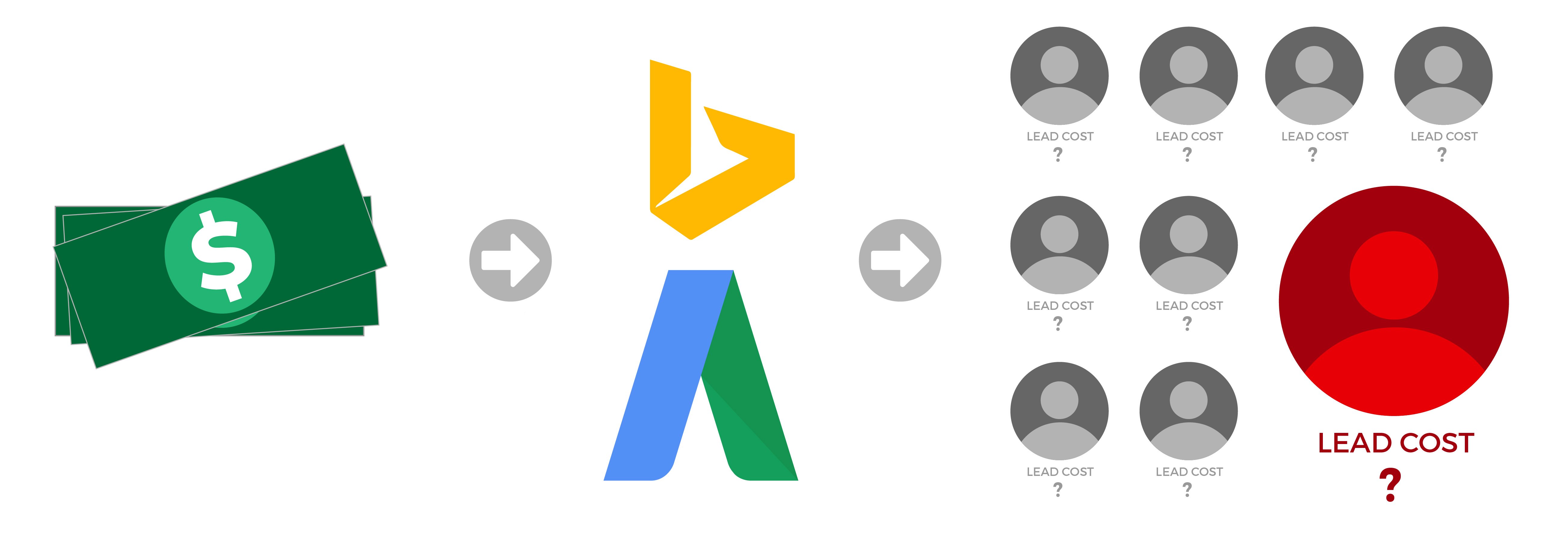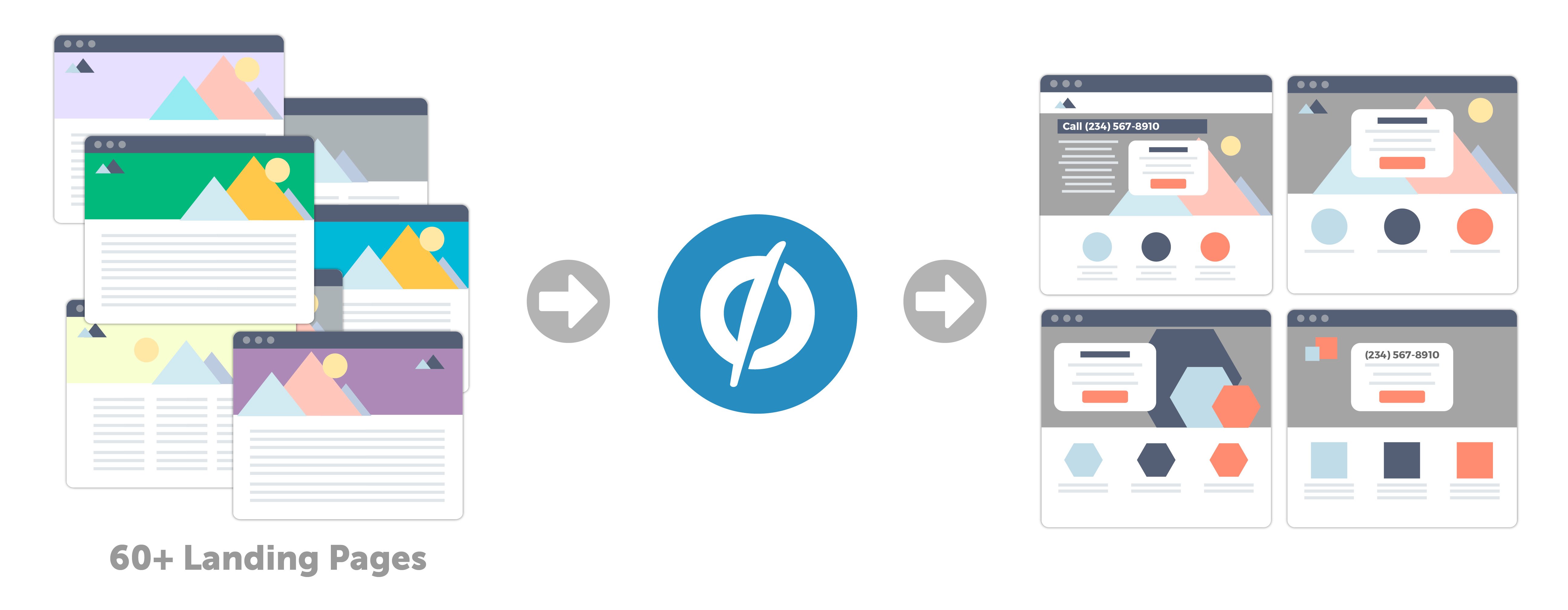We have to admit: When a prospective client contacted us, we weren’t exactly sure how “ground penetrating radar” or “electromagnetic induction” work. Frankly, it’s still a mystery. But with a lot of problem solving and geeking out, ParaCore helped put this unique business on the map. This is the story of a company that needed help optimizing their PPC efforts to drive better results, and how we saved them thousands of dollars along the way. Because they’re in a super-specialized niche with only a handful of competitors, we’ll keep their name under wraps and call them by a fancy name: “The Inspection Company.”
First thing first, how well is the campaign performing?
The Inspection Company was spending over $10,000 each month on Bing and AdWords ads, so they were no stranger to paid advertising. They knew the ads were generating significant call volume, but they didn’t know exactly how many calls or what keywords were responsible for the activity.  A major reason for this was lack of visibility into exactly what was going on under the hood. Conversion tracking wasn’t set up correctly, so they couldn’t pinpoint which campaigns, keywords, or markets were generating leads. And while they knew that paid advertising was bringing in business, they weren’t sure how many leads it was providing or how to get the same number of leads for less money. To make things even more complicated, they also had over 60 individual landing pages targeted toward different market segments. Segmenting is an important part of an effective pay-per-click campaign, but organizing a large collection of landing pages can be tricky.
A major reason for this was lack of visibility into exactly what was going on under the hood. Conversion tracking wasn’t set up correctly, so they couldn’t pinpoint which campaigns, keywords, or markets were generating leads. And while they knew that paid advertising was bringing in business, they weren’t sure how many leads it was providing or how to get the same number of leads for less money. To make things even more complicated, they also had over 60 individual landing pages targeted toward different market segments. Segmenting is an important part of an effective pay-per-click campaign, but organizing a large collection of landing pages can be tricky.
Over 60 landing pages reduced to just 4 with dynamic tracking
The first order of business was to make those landing pages more manageable. We recreated the pages in Unbounce, cutting the total number from 60+ to just 4. Using Unbounce’s Dynamic Text Replacement feature, we were able to keep the hyper-segmentation in place and customize those four pages so users would see different content depending on their location or market segment. This meant that the landing pages could still deliver over 60 customized messages by market, but the management and maintenance would be much simpler over just 4 pages.  Next, our team dove into The Inspection Company’s campaign setup. We found that over 76% of their leads came from phone calls, but there was so much more we could do to optimize their PPC campaigns if we had more data. To fix this, we implemented call tracking, which uses dynamic phone numbers to track the source of each phone call (search engines, direct traffic, etc.). Tracking was setup in both CallRail and AdWords so calls could be attributed to individual keywords and ad groups. We also added tracking to the form submissions to better understand which market segments were engaging the most people and which landing page they visited.
Next, our team dove into The Inspection Company’s campaign setup. We found that over 76% of their leads came from phone calls, but there was so much more we could do to optimize their PPC campaigns if we had more data. To fix this, we implemented call tracking, which uses dynamic phone numbers to track the source of each phone call (search engines, direct traffic, etc.). Tracking was setup in both CallRail and AdWords so calls could be attributed to individual keywords and ad groups. We also added tracking to the form submissions to better understand which market segments were engaging the most people and which landing page they visited.  Once the campaign structure was optimized and the leads were being tracked, our team shifted our focus to keywords. To reach customers in their specialized industry, The Inspection Company had researched a collection of targeted keywords that were bringing in a decent amount of traffic. However, not all of them were performing well, so we reviewed the PPC analytics and added negative keywords to their PPC campaigns. Initially, we performed negative cleansing daily due to the excessive amount of wasted traffic. We then transitioned into more periodic review to make sure the keywords are always relevant. This not only helped attract more qualified visitors who are more likely to convert, but also reduced their costs by pausing poor-performing keywords that were wasting budget.
Once the campaign structure was optimized and the leads were being tracked, our team shifted our focus to keywords. To reach customers in their specialized industry, The Inspection Company had researched a collection of targeted keywords that were bringing in a decent amount of traffic. However, not all of them were performing well, so we reviewed the PPC analytics and added negative keywords to their PPC campaigns. Initially, we performed negative cleansing daily due to the excessive amount of wasted traffic. We then transitioned into more periodic review to make sure the keywords are always relevant. This not only helped attract more qualified visitors who are more likely to convert, but also reduced their costs by pausing poor-performing keywords that were wasting budget. 
$30k in savings and 40.7% reduction in CPL
With correct conversion tracking and call tracking in place, we gained better visibility and better results. After reviewing the data, we found that 55% of leads came from calls made after seeing the new Unbounce landing pages, 24% came from landing page forms, and roughly 20% came directly from ads. This information continues to guide our efforts as we optimize the company’s PPC campaigns to bring in the highest quality leads at the lowest cost. Our keyword analysis also paid off. In the first two months of implementation, we followed conversion data to identify the keywords that were eating up the ad budget without producing good returns. After turning off all those unnecessary keywords, we saved The Inspection Company over $30,000 in the first year. Plus, when we added negative keywords to the campaigns, the cost-per-lead decreased by 40.7% in the first three months. Mission accomplished!
Curious what we could do for your business?
At ParaCore, we spend our days immersed in PPC so you don’t have to. As The Inspection Company discovered, our team geeks out over optimizing campaigns. Whether your goal is to increase leads, lower cost-per-lead, or all of the above, we’re here to help – and we’ll show you exactly how we do it. Reach out for a free, no-strings-attached consultation to learn more and get started or jump here for those seeking PPC management Phoenix in Arizona.
Related Posts
- What Is The Difference Between PPC and SEM?
- A Business Guide to Google Ads Auto-Tagging: Tracking Made Easy!
- PC Audit Handbook: How to Analyze Your PPC Campaigns
- The Best PPC Tools of 2022, As Told by PPC Experts
- Beginner’s Guide to UTM Tags & Tracking
- Generate Leads with Facebook Lead Ads
- Cost-per-click vs. cost-per-acquisition: Are you tracking the right PPC metrics?
- How Does Pay Per Click Work?
- Benefits of PPC
- Why Should I Invest in PPC?
- What is Google PPC Advertising?
- Facebook Retargeting Strategy
- How to Use AdWords Negative Keyword Lists
- Introduction to ManyChat
- AdWords Demographics – Education, Children, Marriage, & Homeownership
- Case Study: Return on Ad Spend Optimization
- Google Ads Promotion Extension
- 🎁🎄 Holiday Ad Spend Strategy
- Is Facebook Ads or Google AdWords Right for You?
- AdWords: Is 3rd Position Better Than 1st?
- Should You Be Running Branded Ads?




